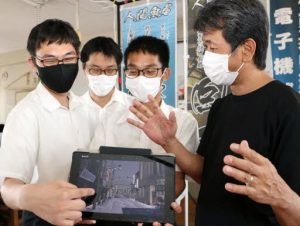Fukuyama Technical High School students develop tablet app for virtual exploration of pre-bombing Hiroshima
Jun. 30, 2020
by Rina Yuasa, Staff Writer
A computation technology research club at Fukuyama Technical High School, located in the city of Fukuyama, has finished the development of an app for use on tablet devices that can reproduce the cityscape of Hiroshima as it appeared before the atomic bombing. Based on stories conveyed by A-bomb survivors, a new feature has been added to the app: the soundscape that people would have heard in those days. Users are able to experience a tour of the former area on top of which the Hiroshima Peace Memorial Park was established after World War II. In July, the high school club members will visit the park and have visitors try the app firsthand.
In the app, when users trace a tablet’s screen with a finger, they can virtually “walk” onscreen from the Motoyasu Bridge to part of the former Nakajima Honmachi area. Users can also enter the Taishoya Kimono Shop, which is now the Rest House, an A-bombed building. New sound effects have been added to the app based on testimonies from A-bomb survivors. For example, when users of the app pass in front of Kuramoto Shokai, a radio shop located next to what is now the Rest House, they will be able to hear “Shanghai Dayori” (Letter from Shanghai), a song that was popular during the war.
Starting five years ago, the club members have worked to create virtual reality (VR) imagery that reproduces scenes in the city of Hiroshima before the atomic bombing. Katsushi Hasegawa, 54, the teacher in charge of the club, handled the technical aspects of the app’s development based on the VR imagery created by the students. Mr. Hasegawa shared with us his expectations for the students. “If they could compare the images on the device with the actual scenes at the site, they would be able to utilize what they can intuit about people’s lives to improve their work.”
The club members are scheduled to visit the Peace Memorial Park on July 11. Riku Sato, 17, a third-year student at school, said, “We will stand in front of buildings that have stood since before the atomic bombing and get a sense of distances, including road widths, so we can make our VR images truer to the original location.”
(Originally published on June 30, 2020)
A computation technology research club at Fukuyama Technical High School, located in the city of Fukuyama, has finished the development of an app for use on tablet devices that can reproduce the cityscape of Hiroshima as it appeared before the atomic bombing. Based on stories conveyed by A-bomb survivors, a new feature has been added to the app: the soundscape that people would have heard in those days. Users are able to experience a tour of the former area on top of which the Hiroshima Peace Memorial Park was established after World War II. In July, the high school club members will visit the park and have visitors try the app firsthand.
In the app, when users trace a tablet’s screen with a finger, they can virtually “walk” onscreen from the Motoyasu Bridge to part of the former Nakajima Honmachi area. Users can also enter the Taishoya Kimono Shop, which is now the Rest House, an A-bombed building. New sound effects have been added to the app based on testimonies from A-bomb survivors. For example, when users of the app pass in front of Kuramoto Shokai, a radio shop located next to what is now the Rest House, they will be able to hear “Shanghai Dayori” (Letter from Shanghai), a song that was popular during the war.
Starting five years ago, the club members have worked to create virtual reality (VR) imagery that reproduces scenes in the city of Hiroshima before the atomic bombing. Katsushi Hasegawa, 54, the teacher in charge of the club, handled the technical aspects of the app’s development based on the VR imagery created by the students. Mr. Hasegawa shared with us his expectations for the students. “If they could compare the images on the device with the actual scenes at the site, they would be able to utilize what they can intuit about people’s lives to improve their work.”
The club members are scheduled to visit the Peace Memorial Park on July 11. Riku Sato, 17, a third-year student at school, said, “We will stand in front of buildings that have stood since before the atomic bombing and get a sense of distances, including road widths, so we can make our VR images truer to the original location.”
(Originally published on June 30, 2020)








